 Chie Roman describes herself as a “rookie pickler”.
Chie Roman describes herself as a “rookie pickler”.
 Annette Ferrer is a self-confessed “food nerd”.
Annette Ferrer is a self-confessed “food nerd”.
At the start of the Luzon-wide community quarantine last March brought about the COVID-19 pandemic, rumors of the government implementing a total lockdown surfaced. In response, many Filipinos flocked to wet markets and grocery stores to secure their food supply. The result? Long and snaking lines of buyers, as well as cleaned-out shelves and stalls as food deliveries from companies and the provinces were delayed by stringent checkpoints.
But the very act of going out to contend with the panic-buying crowd was already a great risk, potentially exposing more people to the deadly virus. The key then was to limit the movement of household members—something that Chie Roman, a mom, found essential since her family shared their apartment building with many other households, including her brother and his family, and even a three-month old. One of the solutions she came up with was pickling.
“My husband and I made it a goal to eat vegetables or fruits every day,” she says. “We couldn’t possibly eat canned food all throughout the ECQ (Enhanced Community Quarantine), so we decided to make pickled vegetables.” Chie’s husband took advantage of his twice-a-month trip to the grocery store or wet market by buying a lot of vegetables, which Chie either froze or pickled. “It’s a good life skill for the kids to learn,” she adds. “It teaches them that food doesn’t always come from the sup.
For Annette Ferrer, a self-confessed “food nerd”, pickling is a natural outlet for her culinary passion. “In my twenties, I taught myself how to cook because I planned on living on my own. Fermentation, dehydration, and all my other kitchen pursuits flow from that desire to be independent and self-sufficient. Very early in the lockdown, I felt very lucky and amazed to have been cultivating this passion for food because now is the time that it will really become handy—a survival tool, not only for the body, but also for the mind.”
Pickling 101
Pickling has been around for thousands of years, likely originating in India, where evidence of pickled cucumbers and mangoes dating back to 2400 BC has been discovered. The method was used to preserve food, and to give it added texture and flavor. Pickling usually involves brine (salt and water solution) or vinegar. While vinegar prevents the growth of bacteria that spoils food, brine prevents spoilage due to oxygen exposure. After a few days, the brine acidifies with the help of good bacteria.
In the Philippines, traditional fermentation in earthen jars has led to a variety of well-loved fare, such as bagoong (fermented shrimp paste), lambanog (palm liquor) and atsara (fermented green papaya, carrots and shallots). To make pickled foods more flavorful, the fermenting liquid is usually seasoned with garlic, ginger, red onions and peppers.
Pickling journey
Chie has always dabbled with making kimchi, but only regularly pickled vegetables during the quarantine. Aside from ampalaya (bitter gourd) and young ginger, her family’s favorite is pickled singkamas (turnip). “My first batch of pickled singkamas turned out better than I expected,” she recalls. “It was crunchy, salty and sweet at the same time. I put a sliver of ginger in each jar. We pair it with anything inihaw (grilled) or fried, but it can also be eaten as a snack.”
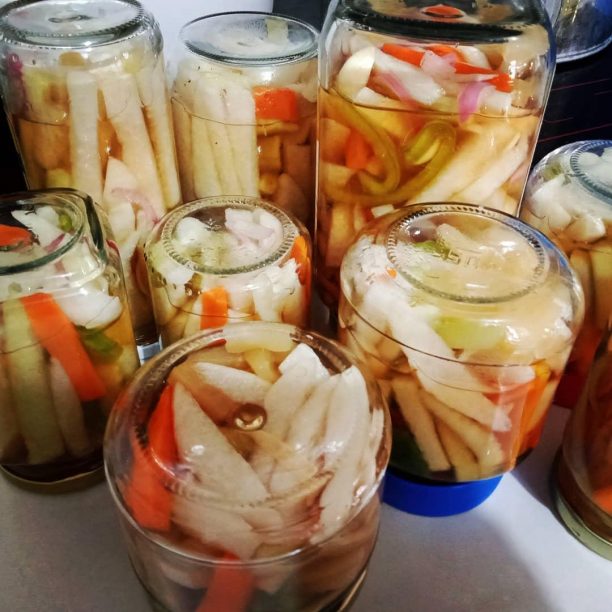 Pickled singkamas
Pickled singkamas
Meanwhile, Annette’s adventurous palate spurred her on to make variations of kimchi—from the usual cabbage to the more unusual combos of apple-radish and kalabasa-sayote (squash-chayote). “Apple-radish kimchi is my favorite! It’s crunchy and sweet. The kalabasa-sayote is creamy and has a nice bite to it.” She also loves fermenting chilis, spicing them with ginger and turmeric, and the more exotic cinnamon and cardamom. “The chilis are great as a sauce. I don’t need to buy hot sauce anymore. After blending and straining my chili sauces, I fry up the pulp and make another sauce—like the chili-garlic you put on siomai, but with a different flavor. The last one I made had apples and raisins in it.”
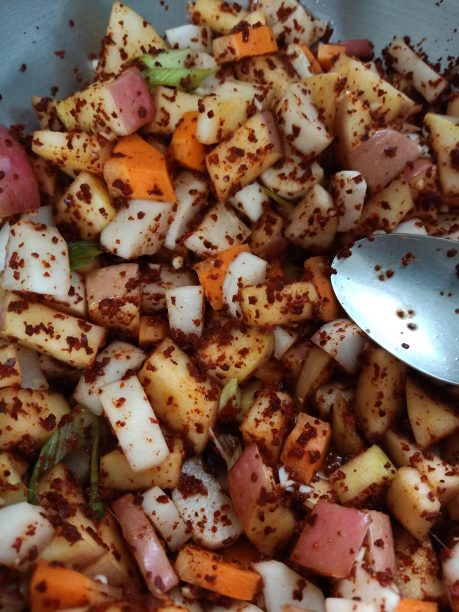 Apple-radish-carrot kimchi
Apple-radish-carrot kimchi
Pickling in the time of a pandemic
Life during a pandemic is rife with uncertainties. For Chie and Annette, pickling is part of the new normal of being self-reliant and thrifty. Chie explains, “We’ve been able to save money and cut down on waste. The vegetable peels, seeds and scraps, we either put in the compost bin or plant in containers.”
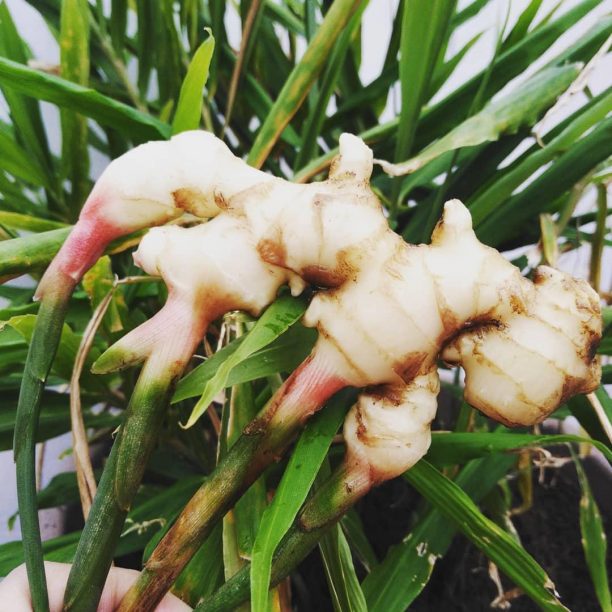 Chie’s ginger harvest
Chie’s ginger harvest
Though Annette is fully aware of how fermentation is an economical and practical means of preserving food, the process also fulfills her on various levels. “It is creative, intellectual, manual, but also nourishing, and a part of resistance and independence. If we only know how to buy our food, we are only consumers in the capitalist system—and there is only ‘one taste’ to things such as sinigang, kare-kare, pancit canton because we eat them from commercial spice mixes. But by making our own food, we are more in touch with our history and culture. Sandor Katz, a fermentation revivalist, says that fermenting is resistance to the idea that bacteria is bad, that everything should be sterile. Fermentation gets us in touch with worlds that are not just ours—the world of yeasts and bacteria.”
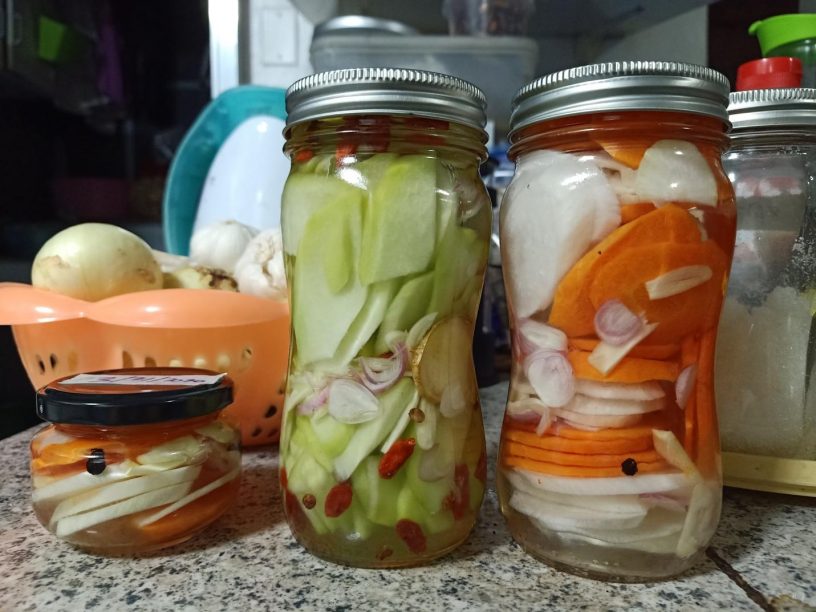 Annette pickles sayote ang goji berry (center); singkamas and carrot (right)
Annette pickles sayote ang goji berry (center); singkamas and carrot (right)
Never-ending gastronomical journey
Both women’s forays into food preparation don’t end with pickling. Chie’s roof deck has become a haven for her container gardens of herbs and vegetables. She also makes homemade yogurt, her family’s source of probiotics that promote digestive health.

Chie dries her basil
Annette has taken on making her own vinegar from fruits such as pineapple, banana, orange and jackfruit. Recently, she’d bought a dehydrator and has since been making dried fruits. “They’re like candy! During the ECQ, we would go to the market once every two weeks. Sometimes, we try to stretch it to three weeks. So you can imagine how the fruits needed to be consumed first. By week two or three, we don’t have any more.”
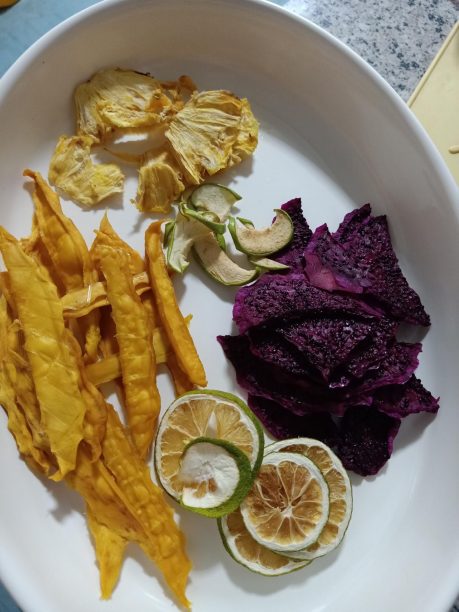 (clockwise) Annette’s dried mango; pineapple; apple; dragonfruit; dayap
(clockwise) Annette’s dried mango; pineapple; apple; dragonfruit; dayap
As for those who want to try pickling, Chie advises, “The most important tip is to make sure you pick the freshest vegetables. Different vinegars yield different tastes. I’ve used rice wine vinegar, apple cider and good old cane vinegar. I still have lot to learn. I am a rookie pickler and Google is my friend.”
Annette encourages beginners to follow their palate. “Start with something you like to eat— if it is kimchi or vinegar, or pickles, or hot sauce! That first success is so encouraging, so aim for simple projects first, then expand.”
4 cloves garlic, minced Half inch ginger, chopped 1 large Fuji apple or 2 small, chopped into 3/4 inch cubes 1 large daikon radish, chopped into 3/4 inch cubes 1 medium carrot, chopped into 3/4 inch cubes 1 bunch spring onions, sliced into 1.5-inch length 1 heaping tablespoon of rock or sea salt Fish sauce to taste 1-4 tablespoons gojugaru or Korean red pepper flakes
- In a large bowl, combine the apple, carrot, radish, salt, garlic, and ginger. Let it sit for about 15 minutes.
- Mix ingredients to check if they have released their juices. Add fish sauce and more salt if necessary.
- Add in 1-4 tablespoons of gojugaru or to taste, depending on how spicy you like it.
- Add in spring onions and stir everything to combine well.
- Transfer the fresh kimchi into a clean glass jar with a non-metallic lid. With a large spoon or with your fist, pack down the kimchi so that the vegetables are submerged in their own juices. Leave about an inch of space at the top of the container for fermentation.
- Cover with the lid and set aside at room temperature overnight or for 2-3 days, depending on how sour you want your kimchi to be.
- When the kimchi has arrived at the level our sourness you enjoy, transfer into the fridge to slow down the fermentation process.
Nutrition Month is a health awareness campaign held every July. It came into being when former President Ferdinand Marcos signed Presidential Decree No. 491 (Nutrition Act of the Philippines) on June 25, 1974, creating the National Nutrition Council to promote good nutrition.
This year’s theme is “Healthy diet, gawing habit for life”, which includes the following components:
- Reduction of obesity
- Prevention of malnutrition
- Helping Filipinos distinguish between healthy and unhealthy foods

Fighting Obesity and Being Overweight
Excess weight occurs when a person has accumulated excess body fat. Since 1980, worldwide obesity has nearly doubled. In 2008, more than 1.4 billion adults were considered overweight. According to the United Nations Food and Agriculture Organization (FAO), the Philippines is one of the developing countries with high levels of obesity. A survey conducted last 2011 showed that 22.3% of Filipino adults are overweight and 6.1 percent are obese.

Why do people become obese?
Consuming too many calories. The energy value of food is measured in units called calories. When we eat and drink, we put energy into our bodies. But eating too many calories and not burning enough of them can lead to weight gain.
Consumption of processed or fast food. Such foods that are high in fat and sugar may appeal to our taste buds, but are detrimental to health. They make you pile on the pounds, but not on the nutrition.
Lack of Physical Activity. People need to exercise to burn excess fat, improve muscle tone, boost energy, and naturally increase your body’s production of the human growth hormone.

Why do people become Overweight?
Excessive food intake that aren’t burned turn into extra pounds. But other factors that aren’t related to diet and a sedentary lifestyle can also cause you to be overweight. Here are some of them:
- According to the archived journals of Disease in Childhood, babies of mothers who smoked during their pregnancy are 48% percent more likely to be overweight. Dr. Stephen Weng of the UK Center for Tobacco Control Studies at the University of Nottingham said that the risk may be because of the poor lifestyle and behavior that many smokers possess. Breastfeeding may help reduce the risk of babies becoming overweight, but babies born to women who smoked weighed less at birth and were breastfed for a shorter period of time.
- Stress is an indirect factor of weight gain. Nutritionist Rita Gatchalian says that when people are stressed, they tend to overeat. This is because the stress hormone cortisol increases one’s appetite. Lack of sleep, also a stressor, may also cause weight gain.

- Some medicines can slow down the rate at which your body burns calories and may increase your appetite or cause your body to hold on to extra water.
- Antidepressants can increase cravings for carbohydrates.
- Steroids tend to cause insomnia, increased appetite and water retention.
- Beta blockers and angiotensin-receptor blockers which lower blood pressure and prevent migraine respectively, slow down metabolism.
Obesity Vs. Overweight
Obesity is a hundred percent increase of the normal weight for one’s body type, while being overweight is 50% higher than the normal weight. Being obese and overweight can lead to diabetes, high blood, and hypertension.
Can an overweight person be malnourished?
Malnutrition or “bad nutrition” is a state in which a deficiency, excess or imbalance of the essential parts of a healthy diet cause measurable effects on body tissue.
Through the years, the term has been associated to people who don’t have enough to eat—people whose bones stick out from their narrow frames. But today, malnourishment has a new face. Overweight people can still be malnourished if they eat foods that don’t have the proper nutrients.
To make sure you are eating a well-balanced diet, remember the following:
- Nothing good comes from eating sugar.
- Avoid too much sodium.
- Protein is good for our body but take note that eating large amounts of protein inhibit the proper functioning of our digestive system.
- Good carbs such as fruits, vegetables, oatmeal, and whole grain can help lower blood cholesterol and heart disease.
- Bad carbs are foods that contain almost no nutrients and are high in sugar. Soft drinks, cakes and ice cream are examples of bad carbs.

The Importance of good Nutrition
Food provides our bodies with energy and nutrients so we can live, grow, and function properly. They can protect us from diseases like heart disease, diabetes and cancer. Eating nutritious foods like fruits, vegetables and whole grains will help you maintain a healthy body weight. It can also delay the effects of aging, and can positively affect your mood and increase focus.
By Panahon TV Intern- Darlene Joy Lodronio
